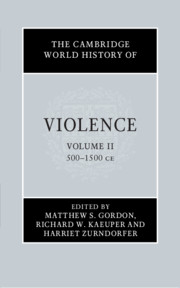Book contents
- The Cambridge World History of Violence
- The Cambridge History of Violence
- The Cambridge World History of Violence
- Copyright page
- Contents
- Figures and Table
- Contributors to Volume II
- Introduction to Volume II
- Part I Beyond Warfare: Armies, Tribes and Lords
- Part II The Violence of Governments and Rulers
- Part III Social, Interpersonal and Collective Violence
- Part IV Religious, Sacred and Ritualised Violence
- 17 Religion and Violence in China
- 18 Buddhism and Violence in Premodern Japan
- 19 Human Sacrifice and Ritualised Violence in the Americas before the European Conquest
- 20 ‘Not Cruelty but Piety’
- 21 Chivalric Violence
- 22 Jihad in Islamic Thought
- 23 Christian Violence against Heretics, Jews and Muslims
- 24 ‘Fighting for Peace’
- Part V Depictions of Violence
- Index
- References
21 - Chivalric Violence
from Part IV - Religious, Sacred and Ritualised Violence
Published online by Cambridge University Press: 13 March 2020
- The Cambridge World History of Violence
- The Cambridge History of Violence
- The Cambridge World History of Violence
- Copyright page
- Contents
- Figures and Table
- Contributors to Volume II
- Introduction to Volume II
- Part I Beyond Warfare: Armies, Tribes and Lords
- Part II The Violence of Governments and Rulers
- Part III Social, Interpersonal and Collective Violence
- Part IV Religious, Sacred and Ritualised Violence
- 17 Religion and Violence in China
- 18 Buddhism and Violence in Premodern Japan
- 19 Human Sacrifice and Ritualised Violence in the Americas before the European Conquest
- 20 ‘Not Cruelty but Piety’
- 21 Chivalric Violence
- 22 Jihad in Islamic Thought
- 23 Christian Violence against Heretics, Jews and Muslims
- 24 ‘Fighting for Peace’
- Part V Depictions of Violence
- Index
- References
Summary
Viewed, as it often still is, from a neo-Romantic perspective, chivalry becomes a force for order and hedge against violence, but this represents decidedly post-medieval conceptions. European medieval chivalry actually constituted the ideals and practices of the warrior elite, elaborating views on licit violence, lived piety, valorized status, gendered relationships, and the distribution of wealth. This chapter takes chivalric violence as its focus, carefully distinguishing when medieval sources are describing reality and when they present idealistic plans for reforming knighthood. The search is for authentic knightly frames of mind and courses of action. Clearly, they needed some framework to guide their demanding lives and as elite warriors obviously essential in their world, they could choose and shape working codes that met their needs and simply ignore or modify troublesomely restrictive conceptions thrust at them. Of the many sources close to practicing knights used in the chapter, two receive special emphasis, the History of William Marshal (the biography of the manor cross-Channel knight of late 12th and early 13thC) and the Book of Chivalry (written by the leading French knight of mid 14thC). Both show the powerful role of this warrior code emphasizing the role of prowess in the search for honour, sustained by religious piety showing divine blessing on knighthood as one sustaining society.
- Type
- Chapter
- Information
- The Cambridge World History of Violence , pp. 426 - 447Publisher: Cambridge University PressPrint publication year: 2020

